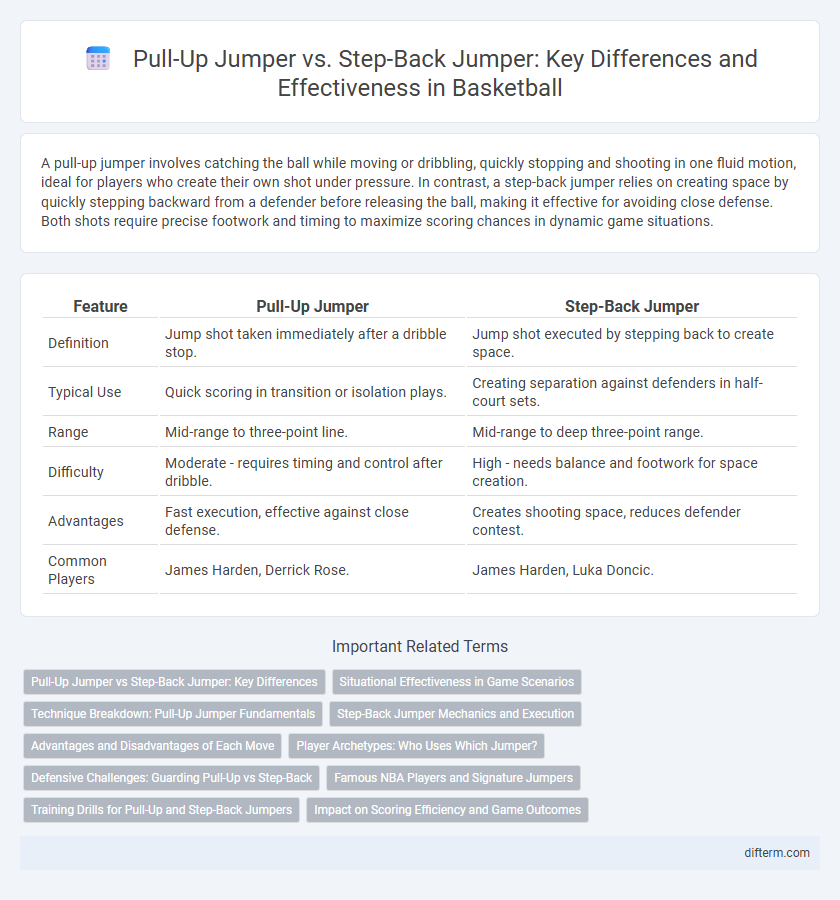A pull-up jumper involves catching the ball while moving or dribbling, quickly stopping and shooting in one fluid motion, ideal for players who create their own shot under pressure. In contrast, a step-back jumper relies on creating space by quickly stepping backward from a defender before releasing the ball, making it effective for avoiding close defense. Both shots require precise footwork and timing to maximize scoring chances in dynamic game situations.
Table of Comparison
| Feature | Pull-Up Jumper | Step-Back Jumper |
|---|---|---|
| Definition | Jump shot taken immediately after a dribble stop. | Jump shot executed by stepping back to create space. |
| Typical Use | Quick scoring in transition or isolation plays. | Creating separation against defenders in half-court sets. |
| Range | Mid-range to three-point line. | Mid-range to deep three-point range. |
| Difficulty | Moderate - requires timing and control after dribble. | High - needs balance and footwork for space creation. |
| Advantages | Fast execution, effective against close defense. | Creates shooting space, reduces defender contest. |
| Common Players | James Harden, Derrick Rose. | James Harden, Luka Doncic. |
Pull-Up Jumper vs Step-Back Jumper: Key Differences
The pull-up jumper involves quickly stopping and shooting immediately off the dribble, relying on explosive footwork and balance, while the step-back jumper creates space by retreating from the defender before shooting. Pull-up jumpers are typically used in fast-break or mid-range situations, leveraging speed, whereas step-back jumpers excel in isolation plays, emphasizing spacing and control. Understanding these distinctions enhances shot selection and defensive strategies in basketball gameplay.
Situational Effectiveness in Game Scenarios
Pull-up jumpers excel in fast-break situations where quick stopping and shooting create high-percentage scoring chances, especially in transition offense. Step-back jumpers prove highly effective in isolation plays, allowing players to create space against tight defenders and reduce contest on shot attempts. Both moves increase scoring efficiency when matched to the appropriate defensive pressure and game tempo.
Technique Breakdown: Pull-Up Jumper Fundamentals
The pull-up jumper requires explosive footwork to create space quickly, typically involving a hard dribble followed by an immediate vertical leap. Proper technique emphasizes balance, hand positioning for consistent release, and maintaining a square shoulder alignment to the basket. Mastery of the pull-up jumper increases scoring efficiency by exploiting defensive closeouts with rapid separation.
Step-Back Jumper Mechanics and Execution
The step-back jumper relies on precise footwork and body control to create space from the defender, initiating with a strong push-off using the lead foot while simultaneously shifting the hips backward. This move requires balance and a quick, explosive upward motion to elevate for the shot while maintaining a controlled release at the peak of the jump. Execution demands coordination between lower body stability and upper body shooting form to maximize accuracy and prevent defenders from blocking the shot.
Advantages and Disadvantages of Each Move
The pull-up jumper offers quick execution and effective creation of shooting space, making it ideal for players facing tight defense, but risks reduced stability and control due to rapid movement. The step-back jumper increases separation from the defender, providing a clearer shot opportunity and better balance, yet it requires more time to set up, potentially allowing defenders to recover. Both moves demand strong footwork and timing, with the pull-up favoring speed and the step-back benefiting precision.
Player Archetypes: Who Uses Which Jumper?
The pull-up jumper is favored by aggressive point guards and shooting guards known for attacking the basket and creating space quickly, such as Stephen Curry and Damian Lillard. In contrast, the step-back jumper is commonly utilized by versatile wings and forwards like James Harden and Kawhi Leonard, who rely on creating separation with a sudden step-back move to find open shots. Understanding these player archetypes helps teams optimize offensive setups based on individual shooting styles and defensive matchups.
Defensive Challenges: Guarding Pull-Up vs Step-Back
Defending a pull-up jumper demands quick closeout speed and vertical contesting, as the shooter often relies on sudden stops and explosive elevation to create space. In contrast, guarding a step-back jumper requires maintaining optimal spacing to prevent the offensive player from gaining separation while anticipating the backward step, challenging defenders to react swiftly without committing fouls. Both shots test a defender's agility and anticipation, but the step-back jumper's deceptive motion often poses greater difficulties in timing the contest effectively.
Famous NBA Players and Signature Jumpers
Pull-up jumpers and step-back jumpers are signature moves mastered by NBA legends like Kobe Bryant and James Harden, respectively, showcasing their unique offensive arsenals. Kobe Bryant's pull-up jumper demonstrated precision and footwork in mid-range scoring, while James Harden's step-back jumper revolutionized spacing and three-point shooting with its quick separation. These iconic jumpers not only highlight player creativity but also influence evolving basketball strategies and training techniques.
Training Drills for Pull-Up and Step-Back Jumpers
Training drills for pull-up jumpers emphasize explosive agility and footwork to create space quickly, incorporating cone drills and closeout simulations to enhance reaction time. Step-back jumper drills focus on balance and precision, using resistance bands and backward stepping exercises to perfect the step-back motion while maintaining shooting form. Combining these drills improves muscle memory and shooting accuracy under defensive pressure, essential for effective scoring in game situations.
Impact on Scoring Efficiency and Game Outcomes
The pull-up jumper generates higher scoring efficiency due to its quick execution, minimizing defender reaction time and creating more open looks at the basket. The step-back jumper, while slower, provides increased space from defenders, resulting in improved shot accuracy and reduced contesting pressure. Teams that effectively utilize both techniques tend to improve overall offensive versatility, positively influencing game outcomes by increasing scoring opportunities and maintaining offensive unpredictability.
pull-up jumper vs step-back jumper Infographic

 difterm.com
difterm.com